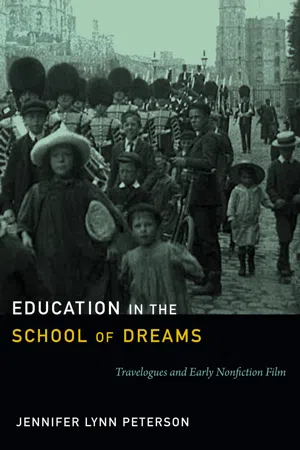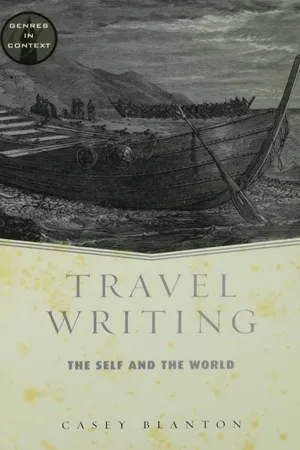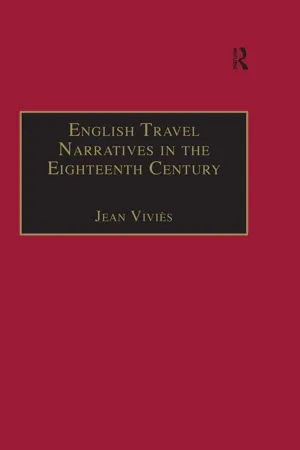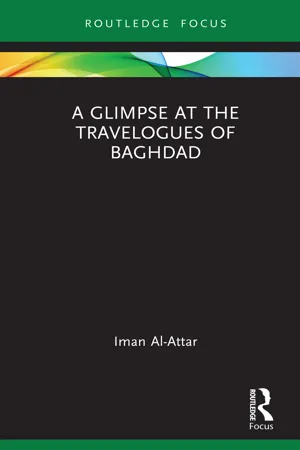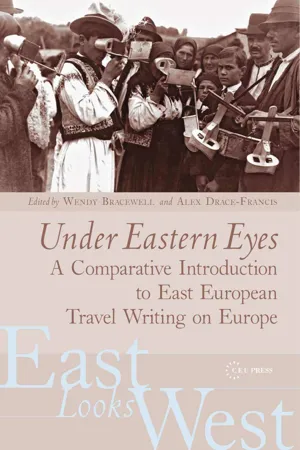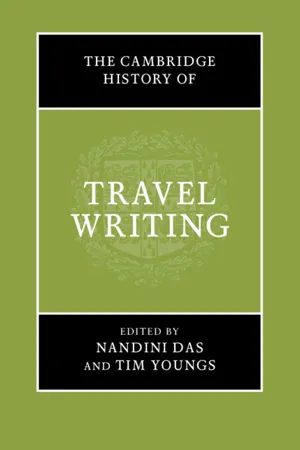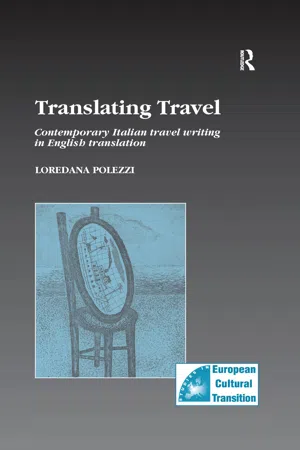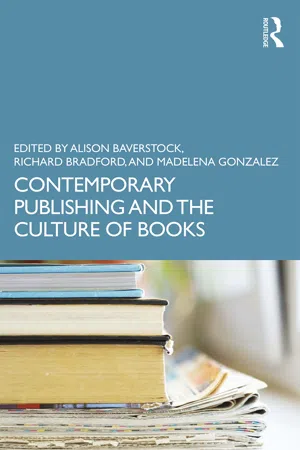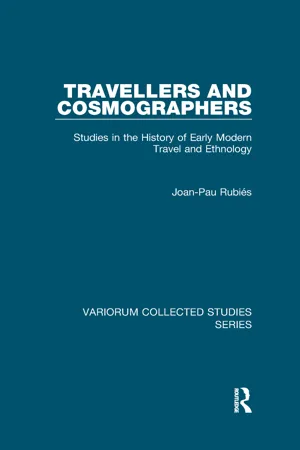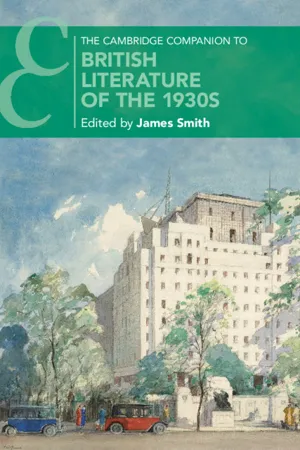Literature
Travelogue
A travelogue is a literary genre that combines elements of travel writing and personal narrative. It typically recounts the author's experiences, observations, and reflections during their travels, often incorporating historical, cultural, and geographical details. Travelogues can provide readers with insights into different places and cultures, as well as the author's unique perspective and experiences.
Written by Perlego with AI-assistance
Related key terms
1 of 5
12 Key excerpts on "Travelogue"
- eBook - ePub
- Glenn Hooper, Tim Youngs(Authors)
- 2017(Publication Date)
- Routledge(Publisher)
Chapter 2Defining Travel: On the Travel Book, Travel Writing and Terminology Jan BormFrom the amount of critical attention and the number of labels applied to travel writing in recent years, one may well wonder whether critics are discussing the same object. Among the wide range of terms in use are: 'travel book', 'travel narrative', 'journeywork', 'travel memoir', 'travel story', 'Travelogue', 'metaTravelogue', 'traveller's tale', 'travel journal', or simply 'travels' (The Travels of Sir John Mandeville ), and, in a different vein, 'travel writing', 'travel literature', 'the literature of travel' and 'the travel genre'. While I do not refute the validity of any of these terms, their sheer abundance raises the question of what we actually mean by the travel book and travel writing . An answer in generic terms is far from being obvious, as Tim Youngs notes in his study, Travellers in Africa :Travel writing feeds from and back into other forms of literature. To try to identify boundaries between various forms would be impossible and I would be deeply suspicious of any attempt at the task.1The point to determine, therefore, is whether travel writing is really a genre at all. I shall argue here that it is not a genre, but a collective term for a variety of texts both predominantly fictional and non-fictional whose main theme is travel. That said, the terms travel book or Travelogue usefully describe a genre known in French as récit de voyage, and in German as Das Reisebuch or Der Reisebericht, a category of texts that are an integral part of travel writing. I will try to illustrate these points by looking at the hybrid nature of the travel book and travel writing, the role of the Active and the referential, as well as at other works of representation. Finally. I would like to stress that the literary is at work in travel writing, and that it therefore seems appropriate to consider the terms the literature of travel, or simply travel literature , as synonyms of travel writing. - eBook - PDF
Education in the School of Dreams
Travelogues and Early Nonfiction Film
- Jennifer Lynn Peterson(Author)
- 2013(Publication Date)
- Duke University Press Books(Publisher)
CHAPTER 1 VARIETIES OF TRAVEL EXPERIENCE Burton Holmes and the Travelogue Tradition T ravel accounts have been produced for millennia, but the Travelogue is a multi-media form that emerged at the dawn of the twentieth cen-tury. The Oxford English Dictionary defines a Travelogue as “an (illus-trated) lecture about places and experiences encountered in the course of travel; hence a film, broadcast, book, etc., about travel; a travel documen-tary.”1 The term is usually considered a neologism by the travel lecturer Bur-ton Holmes. The film historian X. Theodore Barber writes, for example, “In 1904 Holmes coined the term ‘Travelogue’ to refer to his show, thereby giving it a greater air of novelty.”2 I have not found corroborating evidence that Holmes coined the term, however, and in fact Charles Musser has located a usage of the word by someone other than Holmes as early as 1899.3 Regard-less of the word’s true origin, Holmes did claim to be its originator, and he was certainly the one who popularized it with his renowned illustrated lec-ture series that toured the United States from the 1890s through the 1950s. Illustrated travel lectures were hugely popular in the late nineteenth cen-tury and early twentieth. In these presentations, live lecturers described for-eign lands before a paying audience, accompanying their talks with magic lantern slides. These public speakers, almost always men, were usually celeb-rity travelers or scholars, which gave them the requisite aura of cultural au-thority to perform as experts.4 Lecturers typically took credit for the photo-graphic images that accompanied their talks, even if they had not taken the slides themselves (lantern slides were manufactured and sold by a number 24 | Chapter 1 of firms).5 John L. Stoddard, Alexander Black, Lyman Howe, and Dwight L. Elmendorf are some of the other prominent American travel lecturers, but Holmes was the most famous of his contemporaries; in his heyday, he was a well-known media figure. - eBook - ePub
- Casey Blanton(Author)
- 2013(Publication Date)
- Routledge(Publisher)
C.E .) are evidence of a vigorous nascent genre. These narratives and the ones that follow them render in words the strange, the exotic, the dangerous, and the inexplicable; they convey information about geography as well as human nature; they try, as Ishmael tried, to tell a kind of truth that paradoxically may be untellable. This compelling urge to describe the journey does not diminish throughout history, and there seems to be no end to the wealth of travel texts. But, as we shall shortly see, both the purpose and the style of these narratives do evolve substantially over time. It is a kind of evolution that betrays its long ancestry because the more narrow group of narratives that we have come to call “the modern travel book” has inherited elements of all of its predecessors as well as its close cousins. This complex family, then, includes memoirs, journals, and ships’ logs, as well as narratives of adventure, exploration, journey, and escape.Despite changes in style and purpose, the effect of these narratives on the reader has not diminished. From Marco Polo to Bruce Chatwin, travelers’ tales about distant places and exotic cultures have proven to be remarkably popular reading. The persistence of this kind of writing is undoubtedly related to human curiosity and to a travel writer's desire to mediate between things foreign and things familiar, to help us understand that world which is other to us. But curiosity alone does not account for the persistence of this genre.What may go further toward explaining travel literature's longevity is its narrative power, both literal and symbolic. The travel narrative is a compelling and seductive form of storytelling. Its reader is swept along on the surface of the text by the pure forward motion of the journey while being initiated into strange and often dangerous new territory. The traveler/narrator's well-being and eventual safe homecoming become the primary tensions of the tale, the traveler's encounter with the other its chief attraction. Indeed, the journey pattern is one of the most persistent forms of all narratives—both fiction and nonfiction. Works as various as the Odyssey, Gilgamesh, Moby-Dick, and the travel books of Mungo Park, Gertrude Bell, and Jan Morris all follow this ancient pattern: departure, adventure, and return. Yet, these works resonate with a symbolic and psychological truth that goes beyond their compelling narrative surfaces. The transformation from a literal journey to a psychological or symbolic one may occur for a number of reasons. The shift works on an intuitive level because of what Joseph Campbell calls the existence of the “monomyth,” where the hero is seen as one who travels along a path of self-improvement and integration, doing battle with the “others” who are the unresolved parts of himself or herself. Wholeness is associated with homecoming when the quest cycle is complete.2 In her book on the journey narrative in American literature, Janis Stout suggests that the symbolic power of these tales resides in “the elemental questions of epistemology, the relation between subject and object, knower and known.”3 - eBook - ePub
English Travel Narratives in the Eighteenth Century
Exploring Genres
- Jean Viviès(Author)
- 2017(Publication Date)
- Routledge(Publisher)
Conclusion The Travel Narrative and Literary CriticismAll narratives are travel narratives.1 Michel de CerteauThe study of travel narratives reveals the lack of grounding theory and analytical tools. Narratology has been mostly interested in fictional narratives. In a recent essay, Gérard Genette acknowledged that, while narratological analysis has underlined narrative modalities at work in all discourse, their application to factual texts is not necessarily straightforward.2 The reason for this is doubtless that the travel narrative has often been seen essentially as a document (informing us about reality) or as a fragment of an autobiography (informing us about its author). Its status as a literary artefact is rarely brought to the forefront.The generic status of the travel journal in relation to the fictional narrative
Travel narratives are more capable of hindering analysis than they are able to further it, and this is especially true of typology. It is revealing that Percy G. Adams brings his study to a close by attempting to define the travel narrative in terms of negative criteria. He tries to give an empirical account, dismissing a whole series of inadequate definitions. These definitions cover a number and a variety of notions, amongst which are the type of narrative voice, the simplicity of the subject matter, the objectivity and the quality of the account. It is worthwhile lingering a moment over each before we attempt to take the matter further.The travel narrative is not necessarily an account or journal written in the first person. Indeed, a random cross-section indicates that the third person is often used. In Boswell's An Account of Corsica, for instance, much space is given to Paoli's acts and gestures, his maxims and his opinions.The texts are not necessarily in prose. There are poetical travel journals or texts illustrated with numerous etchings. Adams does not offer any English examples but evokes the astronomer Jérôme Lalande's Journal d'un voyage en Angleterre (1763), the text of which is indeed illustrated by drawings and maps.3 The travel narrative is not necessarily a simple or linear tale in contrast to the complexities of plot associated with the novel. The example of Defoe is eloquent in this case, for the complex, narrative engineering of Tour thro' England and Wales - eBook - ePub
- Iman Al-Attar(Author)
- 2022(Publication Date)
- Routledge(Publisher)
Typically, travel writings place a great emphasis on the visual quality of a place, and on its generic appearance. The traveller usually approaches the city with particular conceptions in his mind. This stage can be considered as the stage of ‘initial recognition’. When the traveller reaches the city, the second stage begins, as he visually perceives the city, his imaginative preconceptions become rationalised. While some of these imaginative pictures improve, others will be reduced or vanish completely, depending on the circumstances of the city. This stage can be outlined as the stage of ‘visual recognition’. The writing of Travelogues in general is the third stage of this framework of comprehension, when the ideas are combined and presented in a specific way that reflects the traveller’s ultimate understanding. This stage can be outlined as the stage of ‘reflective recognition’. These steps show the crucial impact of each individual’s experience and intentions on the context of his writing.In contrast to the theme of passionate expression that is exposed in poetry and literature, discovery usually distinguishes Travelogues from other types of historical writing. Discovery involves observing, revealing, finding and interpreting, in addition to disclosing facts and documents. Historically, the theme of discovery took a broader meaning, when it attempted to organise different interpretations of specific issues in society, such as sociability and entertainment. Chard classifies travel writing at the end of the 18th century into two categories; the romantic view of travel and the touristic view.1 Within the romantic view, travel is considered a form of personal adventure that holds out a realisation of self through the exploration of the other. It also entails crossing symbolic as well as geographical boundaries and inviting different forms of danger and destabilisation.The second approach is the view of the tourist “who recognises that travel might constitute a form of personal adventure, and might entail danger and destabilisation, but … attempts to keep the more dangerous and destabilising aspects of the encounter with the foreign at bay”.2 - eBook - PDF
Under Eastern Eyes
A Comparative History of East European Travel Writing on Europe
- Wendy Bracewell, Alex Drace-Francis, Wendy Bracewell, Alex Drace-Francis(Authors)
- 2008(Publication Date)
- Central European University Press(Publisher)
The Travel Narrative as a (Literary) Genre David Chirico The study of travel narratives reveals the lack of grounding theory and analytical tools. […] The rea- son for this is doubtless that the travel narrative has often been seen essentially as a document (informing us about reality) or as a fragment of an autobiography (informing us about its author). Its status as a literary artefact is rarely brought to the forefront. 1 ASSUMPTIONS, QUESTIONS AND STUDIES Each of the essays in this volume looks at east Europeans who trav- elled within Europe. They came from different cultural traditions, travelled in different centuries and to different destinations, and had different aims, or no aim at all, in travelling. What all have in com- mon is that they wrote texts about their travels. The texts themselves are widely different: some long and some very short; some intended for publication, some private; some polemical, some descriptive, some lyrical, some driven by a narrative plot; some of high aesthetic value and some of none; some interesting and some astonishingly dull. It is implicit, however, in the decision to publish a collection of essays on east European travel writing, and indeed to publish bibliographies and anthologies of travel writing texts, that there is something in common, a set of features which enable a more or less clearly defined category to be drawn up, however provisionally, within which some texts can be included and from which some, just as importantly, can be excluded. One aim of this essay is to frame, and begin to answer, some ques- tions about the significance of the formal, thematic and social/histori- 1 Jean Viviès, English travel narratives in the eighteenth century: Exploring genres, trans. C. Davison (Aldershot: 2002). 28 Under Eastern Eyes cal factors which unite these texts. - eBook - ePub
- Zoë Kinsley(Author)
- 2016(Publication Date)
- Routledge(Publisher)
It is not easy to categorize the travel text. This is made clear in Elizabeth Spence’s assertion that travel writing is a form which embraces ‘arts, antiquities, and history, natural or historical anecdotes’, and all branches of science. And it is still being made manifest in today’s bookshops where travel narratives are sometimes shelved in a ‘travel’ section where Daniel Defoe rubs shoulders with Rough Guides, elsewhere inhabit the autobiography section or alternatively might be located under the hybrid heading of ‘travel-autobiography’. What the latter modern classificatory choices reveal in contrast to Spence’s early nineteenth-century representation of the form, is that the Travelogue has come to be widely perceived as a very personal form of writing, indeed a subgenre of life-writing. A consideration of manuscript travel texts by women writing between the late seventeenth and the early nineteenth century reveals that assumption to be a problematic one, however, just as they demonstrate that scribal texts cannot be uncritically read as unprofessional, existing outside the conventions of print literature, or as a form of writing to which public readership is denied. What becomes clear through a comparison of manuscript to printed texts is that travellers differ in the degree to which they feel the need to differentiate between narration of self and narration of place, personal and social or public material. Whereas Celia Fiennes actively employs travel narration in order to facilitate the construction and confirmation of personal and familial identity, and Dorothy Wordsworth is painfully aware that the circumstances of her personal life shape the way in which she writes about home tour experiences, Dorothy Richardson is adamant that travel writing is not a forum for what she describes as ‘private’ discourse. Whilst some travel writers do distinguish between personal and public subject matter, for others that dichotomy is not meaningful. The differences in these women’s attitudes towards travel writing are determined by a complex of contextual factors which shape their work: the historical, social and literary environment in which they are writing, the personal concerns of the author and the expectations of the particular reading audience for whom the text is constructed. - eBook - PDF
- Nandini Das, Tim Youngs(Authors)
- 2019(Publication Date)
- Cambridge University Press(Publisher)
11 What appears to be a highly individualistic experience and presentation of travel and adventure also conforms to and produces common patterns, repetitions, and conventions. Since blogs are often written in a casual, informal style, or as incomplete impressions, narrated in the moment, we may be tempted to think of today’s reflections on travel experiences as less serious than in the past. Yet travel writing has often been prone to falsifications and mythmaking. Not all works of popular travel writing in centuries past were erudite, objective anthro- pological studies. The great majority of travel writing – most of it now forgotten – circulated in popular print and was often misleading and mis- informed, or else was designed to serve an entirely different purpose (such as being a vehicle for satire or parody of political figures or systems when censorship precluded more direct political comment). 12 While today’s travel commentaries may be shorter (as short as a 140- or 280- character post on Twitter or similar social media networks), they are generally being produced by a much more literate and well-informed global citizenry. Of course, they can still be equally misleading or misinformed. 13 Cardell and Douglas note that the travel blog should not primarily be demarcated by form, but rather by its rhetorical mode, whose appeal is ‘tied to its authenticity as a first person, eyewitness account and to the author’s persona as an honest autobiographer of their experience’. 14 These qualities can also be considered as standard characteristics of much travel writing in past centuries. Identity performances on these blogs are laboriously mediated, dramatised, scripted, and edited, in order to highlight the eventful- ness of people’s lives. - eBook - ePub
Translating Travel
Contemporary Italian Travel Writing in English Translation
- Loredana Polezzi(Author)
- 2017(Publication Date)
- Routledge(Publisher)
46 Travel writing:confronts, at their extreme limit, representational tasks proper to a number of literary kinds: the translation of experience into narrative and description, of the strange into the visible, of observation into the verbal construct of fact; the deployment of personal voice in the service of transmitting the information (or of creating devotional texts); the manipulation of rhetorical figures for ends other than ornament, (p. 6)The strain between the need to inform the reader and the fascination exercised on writers as well as audiences by the exotic and even fantastic potential of travel is a central theme in contemporary studies of travel writing. Campbell is particularly interested in the evolution of the narrative representation of the self and of what she calls ‘the inward feeling’ of the traveller: the development of a subject position and a voice which transforms him (or, less frequently, her) into a fully developed character, a protagonist with whom the reader is invited to identify. The same line of enquiry brings other critics to follow the evolution of the narrativisation of the traveller’s subjectivity and voice from the point where Campbell left it, in the seventeenth century, to our day. Susan Stewart, for instance, notes that ‘between the eighteenth and the nineteenth century the paradigm of travel writing shifted from supposedly ‘disinterested’ observation to biographical narrative’, determining conspicuous renegotiations ‘in the tension […] between description and narration’47 John Pemble traces the development of this move from the objective to the subjective mode in Victorian and Edwardian times, focusing on ‘the contributions of notable writers who gave the travel book a new function as literary portmanteau, with elements of autobiography, disquisition and essay’, and noting that the travel book ‘was a personal testament, describing an inward as well as an outward journey, and serving as a vehicle for random fragments of description, opinion, and erudition.’48 Mark Cocker describes a further shift towards subjectivity at the beginning of the twentieth century, when the focus moved from ‘the novelty of the data’, to ‘the manner of its presentation’, so that the chronological order of the travel account, and even its factual nature, were called into question.49 The gradual move from the predominance of factual information to that of individual experience is also confirmed by Colin Thubron, who, however, locates the decisive moment for this shift nearer to our days. Thubron maintains that in most Victorian travel books value was still placed primarily on useful and interesting factual information.50 - eBook - ePub
- Alison Baverstock, Richard Bradford, Madelena Gonzalez, Alison Baverstock, Richard Bradford, Madelena Gonzalez(Authors)
- 2020(Publication Date)
- Routledge(Publisher)
12The History and Influence of Travel Writing
Peter BolanIntroduction
The desire to travel, to seek out and explore new places, to fuel one’s curiosity and experience that which is different is quite simply part of the human psyche. The influences on such desires can be many and varied, especially in today’s fast-paced and media-dominated world. One early inspirational influence on travel has been that of the written word. The range is very wide, but whether travel-specific writing with the intention of informing and inspiring others to make similar journeys (e.g. guidebooks), or the influence of novels, poetry, and other written art forms featuring travel and associated choices, there can be no doubting the profound impact this medium has had.Indeed there can be strong synergies between tourism and the literary world which has given rise to specific forms of niche tourism such as ‘literary tourism’. An aspect this essay addresses before examining in more depth the history of travel writing and its influence through the ages from ancient Greece, through the time of the Grand Tour to the advent of the travel blogger and digital influencer of today’s modern world. In the travel planning process for the traveller there are many questions to be answered.What does the tourist expect to experience during their trip? How do they assess the travel experience amid the various other areas of their life? What are their expectations regarding the encounter with host communities, in terms of how they perceive themselves, their home country and their place as tourists? And what historical, cultural, economic, social, and geopolitical processes have constructed these expectations and perceptions at any given time and place? (Mazor-Tregerman, 2015). The answer to many such questions lies in travel writing. The written accounts of other travellers and their experiences, whether in diary form, that of a novel, a poem, or a dedicated guidebook has a profound effect in a myriad of ways. The essence of this essay is to address this. - eBook - ePub
Travellers and Cosmographers
Studies in the History of Early Modern Travel and Ethnology
- Joan-Pau Rubiés(Author)
- 2023(Publication Date)
- Routledge(Publisher)
6 Rather, the growth of the European literature of travel, both overseas and within Europe, goes far beyond any Greek, Latin, Arab, Persian or Chinese precedents and parallels. It is in fact historically unique. It can be seen as a defining peculiarity (rather than a mere consequence) of the new kind of colonial imperialism created by Europeans in the early modern period, one which went beyond its otherwise crucial economic motivations, the desire for trade and bullion, or political ones, the fierce competition amongst rival European powers. The growth of travel literature was, more generally, a major element in the definition of Europe’s cultural transformation from its medieval background to its invention of modernity.In determining reasons for the growth of ethnographic travel writing in Europe it is crucial to analyse the relation between practical aims, ideological assumptions, and philosophical or scientific concerns. If we define ethnography as the description of peoples in their variety, a practice often ruled by implicit assumptions rather than by explicit theories, we may distinguish ethnology as a theoretical discourse on human unity and diversity (racial and cultural) which makes use of ethnography and is a subject of debate within a scientific (but not necessarily academic) discourse. The emergence of a formal scholarly discourse based on comparison, classification and historical lineage called ethnology (eventually as part of the academic discipline of anthropology with which it largely overlaps) is a nineteenth-century phenomenon.7 However, in reality both ethnography and ethnology existed previously within the humanistic disciplines of early modern Europe, in the primary forms of travel literature, cosmography and history, and also in the form of some specific debates, like those relating to the capabilities and origins of American Indians, the definition of ‘natural man’, the influence of climate on national characteristics, or the existence of stages in the history of civilization.8 On the back of the growth of travel literature both ethnography and ethnology were, in fact, crucial to the Enlightenment project of a world-historical science of mankind.9 However, whilst from the end of the sixteenth century one may argue that ethnological concerns sometimes lay behind the ethnographic impulse, more generally, and especially in the earlier centuries of European expansion, travel writing generated ethnography as a matter of course, quite independently from any specific intellectual agenda. Despite this variety of forms of travel writing, it may be possible to generalise that the desire for information, for mainly practical purposes, lies behind the growth of the European genre of non-fictional travel writing throughout the Renaissance. From the sixteenth-century collections of Richard Eden and Richard Willes, who published English translations of Iberian and Italian sources of the New World and Asia, and especially from the Principal Navigations of Richard Hakluyt, whose nationalistic program of English commercial and colonial expansion overseas did not impede a strong sense of the importance of the accurate reproduction of first-hand observations, many of the primary sources (European or English) published by these well-educated editors were written by merchants, soldiers and sailors charting unmapped territories, or by clerics who accompanied them – men with often immediate practical aims in mind.10 - James Smith(Author)
- 2019(Publication Date)
- Cambridge University Press(Publisher)
The dismissal of one’s own exploits contributes to the construction of a self-deprecating, ironically confident narrator. The factors above, together with reflections on the effects of new, speedier forms of travel, affect the presentation of the self, the representa- tion of others, and the relationship with one’s environment. They all have radical implications for travel writing. Burton goes so far as to assert that modernism: calls into question the original premises of the travel genre, particularly its long-standing ambition to describe peoples and places so persuasively that the text is deemed veracious. The twentieth-century traveler thus writes from a precarious, uncertain position [. . .]. 24 The texts’ material contexts and their literary form do not exist in isolation from each other. Most critics of travel writing testify to the genre’s amorphousness, explaining that it overlaps with and is composed of various types of writing that include letters, the diary, memoir, the essay, scientific report, journalism, and fiction. 25 The often deliberate blurring of these generic boundaries that occurs in the 1920s and 1930s may be read against the background of the threat to international borders affecting countries such as Poland, Abyssinia, Austria, and Czechoslovakia. Auden’s early poetry, for example, shows a preoccupation with frontiers, and Letters from Iceland contains a reference to the Nazis, as does Greene’s Journey Without Maps. 26 The travel books also play with conventions and readers’ expectations. In Auden and Isherwood’s book of travel to the Sino-Japanese War, Journey to a War (1939), a photograph captioned ‘Enemy Planes Overhead’ has no aeroplanes in it but instead shows two men crouching, one of them in military uniform, looking at an angle into the sky. 27 This mismatch between what the caption leads us to expect and what we can actually see makes us aware of how we are normally led to look.
Index pages curate the most relevant extracts from our library of academic textbooks. They’ve been created using an in-house natural language model (NLM), each adding context and meaning to key research topics.

